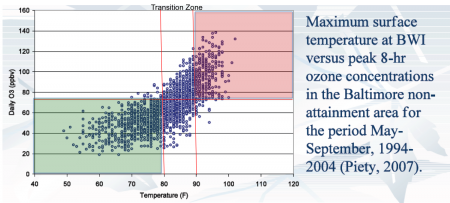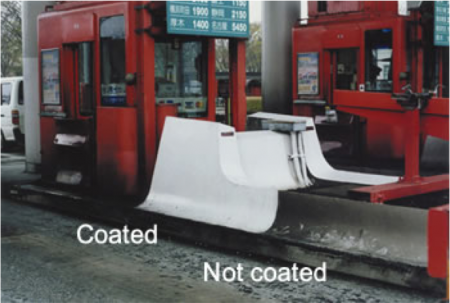Your cool roof lowers air temperatures, improving the air you and your neighbors breathe.
Smog needs heat to form, so lowering air temperatures with reflective roofs can go a long way to reducing the formation of smog. Ozone pollution is a major contributing factor to respiratory illness, which the World Health Organization predicts will be the third leading cause of death by 2030.
Smog forms when a group of air pollutants warm up to a particular temperature. Studies like Climate Central’s Hot and Getting Hotter report show a very clear link between heat and smog formation. Traditionally, air quality improvement efforts have focused on reducing the emission of those precursor chemicals, but turning down urban temperatures would also play an important role.
The relationship between heat and smog formation is not linear. Similar to energy use, there is a threshold temperature, often between 75°F and 80°F (24°C and 27°C) that triggers formation. That means that every small reduction in temperature, especially on warm to hot days, can have a significant impact on air quality. The graph below is a comparison of ozone concentrations to maximum daily temperatures as measured at the Baltimore Washington International Airport. The horizontal line indicates the maximum concentration allowed by EPA at the time. At 80°F (27°C), almost all “days” are within compliance (as shown in the green box). At 90°F (32°C), nearly every “day” is out of compliance (as shown in the red box).

Reflective roofs contribute to energy efficiency, which means a reduction in pollutants emitted from power plants in many parts of the country. White, photocatalytic roofs can even remove NOX pollution from the air.
The energy efficiency benefits of cool roofs reduce the amount of cool electricity demand from cities, which has the benefit of reducing the pollutants associated with electricity generation. Levinson 2010 details this benefit down to a zip code level for the United States.
An emerging technological advancement for cool coatings and surfaces is the increased use of photocatalytic components like titanium dioxide. In unscientific terms, photocatalytic materials interact with certain pollutants and, with sunlight, can render them harmless. This reaction allows materials with photocatalytic properties to remain cleaner for longer period of time and “eat” smog forming chemicals from the surrounding air. The photo below, taken from a presentation by PureTi, shows the condition of the photocatalytic coating 6 months after application.

Across the U.S., the potential energy and air quality savings resulting from increasing the solar reflectance of urban surfaces is a multi-billion dollar economic opportunity.
The improvements in air quality resulting from reductions in urban temperatures that are possible from moderate deployment of cool roofs have a substantial economic benefit. Akbari summarizes some of the economic impact studies of reduced health care costs and improved productivity that result from cooling cities. More recent analyses by Capital E point to similarly substantial economic benefits from improved air quality. That analysis found that converting a 1 square foot of dark roof to a reflective surface would generate $2.67 ($29.02 per square meter) of economic benefit, just from reduced particulate and ozone concentrations.